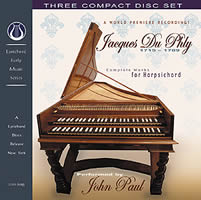Jacques Du Phly: Harpsichord Works
|
Edward Sandel & Gerardo Tango [November 2005.]
Jacques DU PHLY: Première Livre (1744), Deuxième Livre (1748), Troisième Livre (1758), Quatrième Livre (1768); Petit-Heugel Edition. John Paul, harpsichord (Anden Houlen double, after Antoine Vaudry, 1691). Lyrichord Discs LEM-8053 (3 CDs) (http://www.lyrichord.com/). Jacques Du Phly / DuFlitz (1715-1789) was the last of the great French clavecinists, a student of D’Agincourt and a contemporary of Corrette, de Mondonville, Daquin, Dandrieu, Boismortier, and especially François Couperin and Rameau, whose music Du Phly’s high-Baroque / gallant style perhaps most closely resembles. As the program notes with this set and the more copious information on the Du Phly website http://jacques.duphly.free.fr/ show, although perhaps somewhat eclipsed by Rameau, Du Phly early gained an outstanding reputation, with Couperin and Balbastre, as an esteemed teacher. He was cited by Rousseau as “an excellent master of the harpsichord, especially in the perfection of ‘le doigte’ … consisting in general of a soft, light, and regular movement” (Jean-Jacques Rousseau, Dictionary of Music, Paris 1768, Volume 1, pp. 211-212). The program notes likewise cite P.-L. Daquin, writing in 1753 that “one discerns a great deal of ‘lightness in his touch,’ and ‘a certain languor,’ which, ‘sustained by ornamentation’ (graces), marvelously renders the characters of his pieces.” Author of Modern Harpsichord Makers (London, Gollancz, 1981) and discussed at length in Chapter 19, “The Modern Harpsichord – New Directions” in Edward Kottick’s recent A History of the Harpsichord (Indiana University Press, 2003), British-born harpsichordist John Paul is choirmaster of St. Andrew’s Episcopal Cathedral and organist at Temple Beth Israel, in Jackson, Mississippi, and has dedicated most of his performing career to the engaging “picture music” of the 18th-century French clavecinists. Paul studied at London’s Royal Academy of Music with Thurston Dart, among others, and has toured as harpsichordist and accompanist throughout the American South and East Coast since 1980 in a series of concerts and workshops. He has previously released two CDs of J.S. Bach’s keyboard music on Lyrichord (LEM-8045 and LEM-8052), harpsichord works by Lambert and Howell on Centaur (CRC-2536), and a joint work of Handel sonatas arranged for sax and basso continuo on Romeo (R-7216). Paul’s Du Phly collection is his latest recording. Du Phly’s Book One comprises 15, Book Two 13, Book Three 9 and Book Four 6 formal dance and character pieces, which are only partially described as “light, airy, and expressive works,” for there is much of the subtle and also outstandingly virtuosic. Perhaps the most famous (always included on Du Phly CDs) is the F-minor rondeau La Forqueray, memorializing the fiery French viola da gambist Antoine Forqueray. The dark and evocative rondeau theme is repeated twice at the beginning, returning as a 16-measure section between varied couplets and some beautiful intervening material. In this piece, as in most others in this collection, Paul’s playing is clean and precise, flexibly joyful and meditative as called for. His refined and restrained tempo shadings produce delicate and expressive effects, never overdone, although the “languor” of Du Phly’s work is somewhat more apparent on other recordings. Ornaments are modest, unforced, and support the piece as a whole, fully consistent with the best practices of Du Phly’s time. Paul’s Du Phly performances establish a standard by which prior and future releases are bound to be measured. An important factor to stress is Paul’s harpsichord, a non-transposing, permanently pitched instrument with A = 392 Hz. The instrument’s acoustic quality is only somewhat less resonant than Mitzi Meyerson’s Taskin copy. Its transparent timbres permit one to hear interior and subordinate textural voices. The recording site, a large irregularly ceilinged hall, lends much to sound clarity. The recording was made at a 24bit/95k sampling rate with two AKG 414 ULBS microphones positioned 25 feet from the instrument. Other than editing, and minimal equalization between the two recording sessions, there is no post-processing of this audiophile-quality CD set. There are currently nine other CDs on Amazon dedicated to the harpsichord works of Du Phly, including Mitzi Meyerson’s Jacques Du Phly: Pièces de Clavecin (MP&G, 2001) and Mario Raskin’s Harpsichord Works: Du Phly (Pierre Verany, 1993). There is also Yannick le Gaillard’s Jacques Du Phly: Intégrale de l’Oeuvre pour Clavecin (ADDA-Radio France, 1989). The recordings and performances fall well short of the survey here reviewed. Since 1950, Lyrichord Discs has provided fine Baroque recordings, currently listing 28 offerings in their catalog, many of which are exemplary. In terms of instrument, performance and engineering, John Paul’s survey of Du Phly’s harpsichord oeuvre is a most welcome addition to Baroque and keyboard collections.
[More
Duphly]
[Previous Article:
Pärt at 70]
[Next Article:
Kipple 4.]
|
